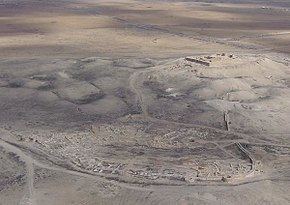Public access National Park | Local time Tuesday 1:11 PM | |
 | ||
Weather 21°C, Wind W at 16 km/h, 24% Humidity Archaeologists | ||
Tel arad aerial view biblewalks com
Tel Arad (Hebrew: תל ערד) or "old" Arad is located west of the Dead Sea, about 10 kilometres (6 miles) west of modern Arad in an area surrounded by mountain ridges which is known as the Arad Plain. The site is divided into a lower city and an upper hill which holds the only ever discovered "House of Yahweh" in the land of Israel. Tel Arad was excavated during 18 seasons by Ruth Amiran and Yohanan Aharoni.
Contents
- Tel arad aerial view biblewalks com
- Map of Tel Arad Arad
- Lower city and upper hill
- Sanctuary at Arad
- References
Map of Tel Arad, Arad
Lower city and upper hill
The lower area was first settled during the Chalcolithic period, around 4000 BCE. Excavations at the site have unearthed an extensive Bronze Age Canaanite settlement which was in place until approximately 2650 BCE. The site was then apparently deserted for over 1500 years until resettled during the Israelite period from the 11th century BCE onwards, initially as an unwalled piece of land cut off as an official or sacred domain was established on the upper hill, and then later as a garrison-town known as "The Citadel".
The citadel and sanctuary were constructed at the time of King David and Solomon. Artifacts found within the sanctuary of the citadel mostly reflect offerings of oil, wine, wheat, etc. brought there by numerous people throughout the reign of the kings of Judah until the kingdom's fall to the Babylonians. However, during the Persian, Maccabean, Roman, and early Muslim eras, locals continued to transport these items to the sacred precinct of the upper hill. Markers of these ancient Israelite rituals remain to this day, with broken pottery littering the entire site.
Under the Judaean kings, the citadel was periodically refortified, remodeled and rebuilt, until ultimately it was destroyed between 597 BCE and 577 BCE whilst Jerusalem was under siege by Babylonian king Nebuchadnezzar II. Among the most significant artifacts unearthed from this time are ostraca dating from the mid-7th century BCE, referring to this citadel as the House of Yahweh.
Habitation of Tel Arad and the upper citadel did not end with the Babylonian siege. During the Persian period (5th – 4th centuries BCE) almost a hundred ostracon and pottery were written in Aramaic, mostly accounts of locals who brought oil, wine, wheat, etc. to the upper hill.
Thus, several citadels were built one upon the other and existed in the Hellenistic and Roman periods. Herod even reconstructed the lower city for the purpose of making bread. The site lasted until the Romans destroyed Jerusalem and completely expelled the "circumcised" in 135 AD. Tel Arad lay in ruins for 500 years until the Islamic period, when the former Roman citadel was rebuilt and remodeled by some prosperous clan in the area and functioned for 200 years until around 861 AD when there was a breakdown of central authority and a period of widespread rebellion and unrest. The citadel was destroyed and no more structures were built on the site.
Sanctuary at Arad
The temple at Arad was uncovered by archaeologist Yohanan Aharoni in 1962 who spent the rest of his life considering its mysteries, dying there in the mid-1970s.
The incense altars and two "standing stones" may have been dedicated to Yahweh and Asherah. An inscription was found on the site by Aharoni mentioning a "House of Yahweh", which William G. Dever suggests may have referred to the temple at Arad or the temple at Jerusalem.
The lower settlement and the upper Israelite citadel are now part of the Tel Arad National Park which have begun projects to restore the walls of the upper and lower sites.
